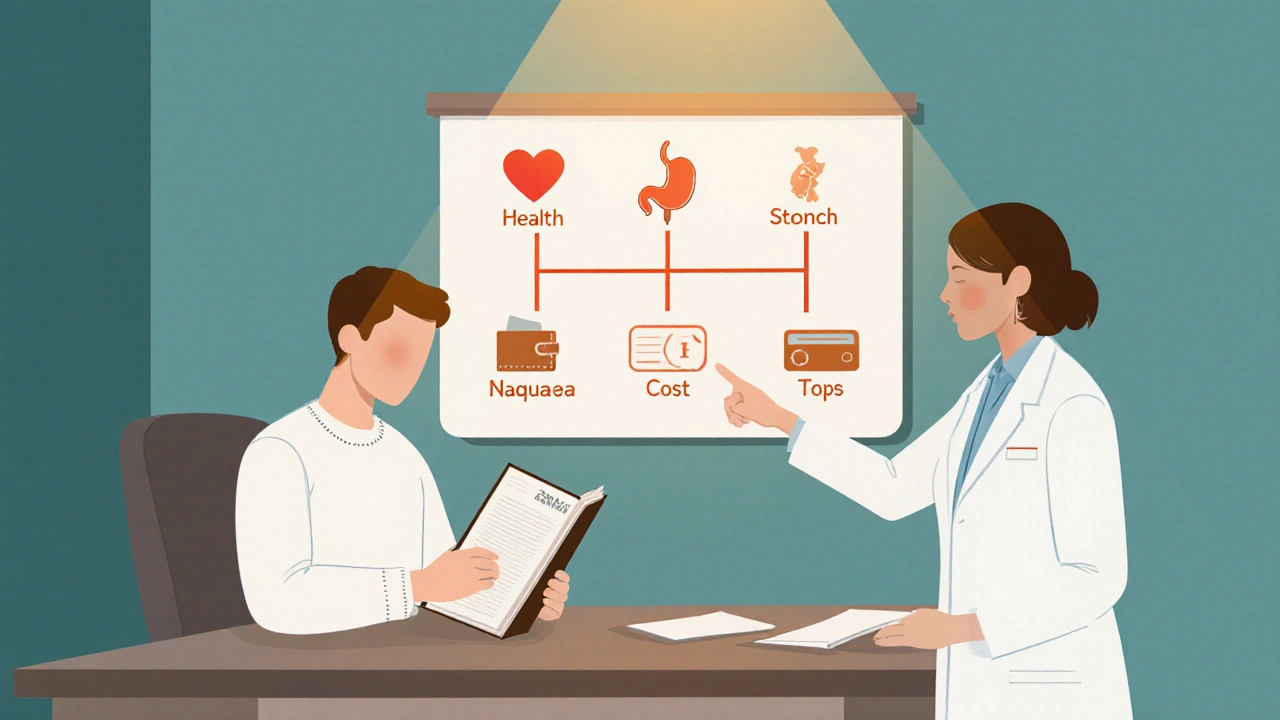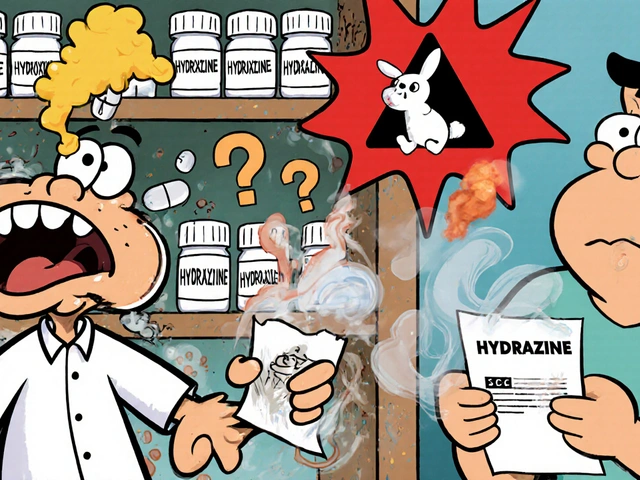Migraine Medication Selector
Enter your migraine details and click "Find Best Medication Match" to see personalized recommendations.
Drug Comparison Guide
Maxalt (Rizatriptan)
Fastest onset (15-30 mins), ideal for typical migraines
Lasmiditan
Safe for heart patients, no vasoconstriction
Rimegepant
Preventive option, long-lasting relief
Quick Takeaways
- Maxalt (Rizatriptan) works fastest for many people, often within 30minutes.
- Newer non‑triptan options like lasmiditan and gepants give relief without vasoconstriction.
- Cost varies: generic rizatriptan is cheapest, newer drugs can be 3‑5× higher.
- Choosing the right drug depends on migraine pattern, heart health, and personal tolerance.
- Always discuss switching meds with a GP or neurologist, especially if you have cardiovascular risk factors.
When migraine attacks hit, most people reach for a tablet that promises quick relief. Rizatriptan - sold as Maxalt in the UK - has been a go‑to for years, but the market now hosts a handful of other triptans and brand‑new classes that avoid the classic vasoconstriction mechanism. Below is a practical, side‑by‑side look at Maxalt and its most popular alternatives, so you can decide which fits your lifestyle and health profile.
What Is Maxalt (Rizatriptan)?
Rizatriptan is a selective serotonin 5‑HT1B/1D receptor agonist used to abort migraine attacks. It was first approved by the MHRA in 2001 and is marketed under the brand name Maxalt. The drug comes in 5mg tablets and, in the UK, a 10mg oral melt‑in‑the‑mouth formulation for faster absorption.
Rizatriptan belongs to the triptan class, the first line of prescription treatment for moderate‑to‑severe migraine when over‑the‑counter painkillers aren’t enough. Its main selling point is a rapid onset - many users report relief within 30minutes - and a relatively low pill burden compared with older triptans that require higher doses.
How Maxalt Works
Rizatriptan binds to 5‑HT1B receptors on cranial blood vessels, causing them to constrict, and to 5‑HT1D receptors on trigeminal nerve endings, inhibiting pain‑signal release. The dual action reduces the swelling and inflammation that drive migraine pain. Because the drug targets serotonin specifically, it avoids the broader serotonergic activity that can cause side effects in older migraine medicines.
Key Attributes of Maxalt
| Attribute | Typical Value |
|---|---|
| Usual Dose | 5mg tablet (or 10mg melt‑in‑the‑mouth) |
| Onset of Relief | 15‑30minutes (median) |
| Duration of Effect | 4‑6hours (can be repeated after 2hours) |
| Average UK Cost (generic) | ≈£1.20 per tablet |
| Common Side Effects | Dizziness, dry mouth, mild chest tightness |
Popular Alternatives to Maxalt
Below are the most frequently prescribed migraine drugs that sit alongside or compete with rizatriptan. Each entry includes a short definition with microdata, so search engines can clearly link the entity to its properties.
Sumatriptan
Sumatriptan is the first‑generation triptan, available as Imigran tablets (50mg), nasal spray (20mg) and subcutaneous injection (6mg). It works via the same 5‑HT1B/1D pathway but has a slightly slower oral onset (≈45minutes) compared with rizatriptan.
Zolmitriptan
Zolmitriptan comes in 2.5mg tablets and a 5mg orally disintegrating tablet (ODT). Its rapid ODT form can hit relief in about 20minutes, making it a good choice for patients who have nausea during attacks.
Eletriptan
Eletriptan is a newer triptan with a 40‑50mg dose that offers one of the highest pain‑free rates among the class. Onset averages 30minutes, and it tends to work well for migraines that last longer than 12hours.
Naratriptan
Naratriptan is available as a 2.5mg tablet, prized for its long half‑life (≈6hours). It’s slower to act (≈60minutes) but can prevent migraine recurrence better than many faster‑acting triptans.
Almotriptan
Almotriptan is taken as a 12.5mg tablet. It offers a balanced profile - quick onset (≈30minutes) and a lower incidence of chest‑tightness compared with sumatriptan.
Lasmiditan
Lasmiditan belongs to the new "ditan" class. It targets serotonin 5‑HT1F receptors, avoiding blood‑vessel constriction altogether. The 50mg tablet can relieve migraine within 45‑60minutes and is safe for patients with cardiovascular disease.
Rimegepant
Rimegepant is a gepant (CGRP receptor antagonist) taken as a 75mg oral tablet. It works downstream of the trigeminal pathway, providing relief without any vasoconstrictive effect. Onset is about 1‑2hours, but it doubles as a preventive dose when taken every other day.
Side‑by‑Side Comparison
| Medication | Typical Dose | Onset | Duration | UK Cost (per dose) | Key Contra‑indications |
|---|---|---|---|---|---|
| Rizatriptan (Maxalt) | 5mg tablet / 10mg ODT | 15‑30min | 4‑6hr | £1.20 (generic) | Uncontrolled hypertension, coronary artery disease |
| Sumatriptan | 50mg tablet / 20mg nasal | 30‑45min | 4‑8hr | £1.50 (generic) | Same as rizatriptan, plus severe liver disease |
| Zolmitriptan | 2.5mg tablet / 5mg ODT | 20‑30min (ODT) | 4‑6hr | £1.30 | Cardiovascular disease, serotonin syndrome |
| Eletriptan | 40‑50mg tablet | 30‑45min | 6‑8hr | £2.00 | Ischemic heart disease, uncontrolled hypertension |
| Naratriptan | 2.5mg tablet | ≈60min | 8‑10hr | £1.60 | Same as other triptans, plus severe renal impairment |
| Almotriptan | 12.5mg tablet | ≈30min | 4‑6hr | £1.40 | Cardiovascular disease, uncontrolled hypertension |
| Lasmiditan | 50mg tablet | 45‑60min | 4‑6hr | £8.00 | None related to vasoconstriction; caution with severe liver disease |
| Rimegepant | 75mg tablet | 1‑2hr | ≈8hr | £11.00 | Pregnancy (category not established), severe hepatic impairment |

How to Choose the Right Migraine Medicine
Picking a migraine drug isn’t just about who works fastest. Here’s a quick decision‑tree you can run through during a GP visit:
- Do you have heart disease or high blood pressure? If yes, avoid classic triptans (rizatriptan, sumatriptan, etc.) and consider lasmiditan or a gepant like rimegepant.
- Is nausea a big problem during attacks? An ODT form (zolmitriptan 5mg) or a nasal spray (sumatriptan) may be easier to keep down.
- Do you need long‑lasting protection against recurrence? Naratriptan’s long half‑life or a preventative dose of rimegepant can help.
- What’s your budget? Generic triptans (rizatriptan, sumatriptan) stay under £2 per dose, while ditans and gepants can exceed £8‑£12.
- Any medication interactions? Check especially for SSRIs or MAO‑inhibitors, which can raise the risk of serotonin syndrome with triptans.
Keep a migraine diary for at least a month - note the drug taken, time to relief, side‑effects, and if the headache returns. Patterns in the diary will make the GP’s job (and yours) a lot easier.
Practical Tips & Common Pitfalls
- Don’t double‑dose too early. Most triptans, including rizatriptan, can be taken a second time after 2hours if pain persists, but exceeding the daily maximum (usually 30mg for rizatriptan) raises side‑effect risk. \n
- Watch for medication‑overuse headache. Using any acute migraine drug more than 10days per month can trigger rebound headaches. If you hit that ceiling, discuss a preventive plan with your doctor.
- Stay hydrated. Dehydration can worsen both migraines and side‑effects like dizziness from triptans.
- Consider timing with food. Rizatriptan’s ODT works best on an empty stomach; eating a heavy meal can delay absorption by up to 30minutes.
- Ask about insurance coverage. In the UK, many NHS prescriptions for triptans are exempt from the prescription charge if you have a chronic condition; newer drugs may require a private prescription.
When to Seek Professional Help
If you notice any of the following, call your GP or go to A&E:
- Chest pain, tightness, or shortness of breath after taking a triptan.
- Sudden, severe headache that’s unlike your usual migraine (possible subarachnoid hemorrhage).
- Persistent vomiting that prevents you from keeping medication down.
- Allergic reaction - rash, swelling, or difficulty breathing.
Early evaluation can prevent complications and help you get on a safe, effective regimen.
Frequently Asked Questions
Can I use Maxalt together with other migraine drugs?
Mixing two triptans (e.g., Maxalt with sumatriptan) is not recommended because the combined vasoconstrictive effect can raise cardiovascular risk. If one dose doesn’t work, you can try a different class - for example, a gepant like rimegepant - after consulting your doctor.
Is rizatriptan safe during pregnancy?
Rizatriptan is classified as Pregnancy Category B in the UK, meaning animal studies have not shown risk but there are no well‑controlled studies in pregnant women. Most clinicians advise using it only if the migraine is severe and other options are unsuitable.
How does lasmiditan differ from rizatriptan?
Lasmiditan targets the 5‑HT1F receptor, avoiding any blood‑vessel narrowing. This makes it a safer choice for people with heart disease. However, it can cause drowsiness and is more expensive than generic triptans.
What should I do if I miss a dose of Maxalt?
Rizatriptan is taken only when a migraine starts, so there’s no regular dosing schedule to miss. If you’ve already taken a dose and the headache returns after two hours, you may repeat up to the daily maximum (30mg). Never exceed that limit without medical advice.
Are there any over‑the‑counter options that work as well as Maxalt?
OTC NSAIDs (like ibuprofen 400mg) can help mild migraines but rarely match the speed and completeness of relief that a triptan such as rizatriptan provides for moderate‑to‑severe attacks. Some people combine an NSAID with a triptan for extra coverage, but you should discuss this combo with a GP.





Melissa Trebouhansingh
October 9, 2025 AT 14:31When one examines the contemporary pharmacoeconomic landscape of migraine therapeutics one is immediately confronted with a stratification that mirrors the very hierarchy of modern medicine. Rizatriptan, marketed under the moniker Maxalt, occupies a position that is both historically foundational and financially modest. Its mechanism, a selective agonism of the 5‑HT1B/1D receptors, is a textbook illustration of targeted vascular modulation. The rapidity with which it attenuates the trigeminovascular cascade is documented across a plethora of controlled trials. Such efficacy, delivered within fifteen to thirty minutes, eclipses the temporal expectations of many older triptans. Nevertheless the clinician must weigh the pharmacodynamic virtues against the specter of systemic vasoconstriction. Patients with occult hypertension or latent coronary insufficiency may inadvertently incur iatrogenic ischemia. In contrast the newer ditan class, exemplified by lasmiditan, eschews any vasoconstrictive action. This pharmacological nuance renders it a viable alternative for the cardio‑compromised demographic. The trade‑off, however, resides in the modestly delayed onset and the propensity for central nervous system sedation. The gepant family, represented by rimegepant, extends the therapeutic horizon into the realm of prophylaxis. Its dual utility as an acute and preventative agent is a noteworthy evolution in migraine stewardship. From an economic perspective the price differential is stark; generic rizatriptan can be procured for roughly one pound whilst a gepant may command a tenfold premium. Such disparity inevitably influences prescribing patterns within publicly funded health systems. The discerning prescriber must therefore integrate clinical phenotype, cardiovascular risk profile, and fiscal constraints into a nuanced decision algorithm. In practice a thorough migraine diary coupled with a shared decision‑making encounter often culminates in the selection of the most appropriate agent.
Brian Rice
October 12, 2025 AT 11:58Your exposition on the pharmacological hierarchy, while erudite, neglects the ethical imperative to prioritize patient safety above cost considerations. One must recognize that the allure of rapid onset can mask the latent dangers inherent in any vasoconstrictive agent. It is incumbent upon the prescribing physician to rigorously assess cardiovascular comorbidities before endorsing rizatriptan. Moreover, the proliferation of newer agents should not be dismissed as mere marketing ploys; they offer genuine therapeutic alternatives for high‑risk populations. The clinician's duty, therefore, extends beyond mere symptom abatement to encompass a holistic appraisal of long‑term vascular health. In neglecting this broader perspective, one risks endorsing a myopic treatment paradigm that may culminate in adverse cardiac events. Consequently, the moral responsibility lies with healthcare providers to engage patients in a transparent dialogue regarding benefits, risks, and economic ramifications. Such discourse safeguards the trust inherent in the therapeutic alliance and upholds the sanctity of medical praxis.
amanda luize
October 15, 2025 AT 09:25While the preceding commentary exhibits a commendable breadth of information, it regrettably suffers from a series of syntactic oversights that merit correction. The phrase “rapidity with which it attenuates” should be rendered as “the rapidity with which it attenuates” to preserve grammatical completeness. Furthermore, the misuse of the em dash in “vascular‑modulation” is inconsistent with standard style guides. Beyond these editorial concerns, one cannot ignore the subtle orchestration by pharmaceutical conglomerates to promote triptans as the default solution, thereby marginalizing emerging therapies that challenge their market dominance. Such strategic bias, embedded within clinical guidelines, suggests a concerted effort to sustain profit streams at the expense of genuine innovation. It is prudent to remain vigilant of these manipulative practices and to scrutinize the data sources that underpin therapeutic recommendations. In doing so, clinicians and patients alike can protect themselves from covert commercial coercion.
Chris Morgan
October 18, 2025 AT 06:51It is naïve to assume that the cheapest option is inherently superior for every migraine sufferer. While generic rizatriptan offers affordability, it fails to address the heterogeneous nature of migraine pathophysiology. Patients with refractory attacks may derive greater benefit from the targeted mechanisms of gepants or ditans, despite the higher price tag. Moreover, the emphasis on cost overlooks the societal expense of medication‑overuse headache, a complication that can arise from frequent triptan consumption. Therefore, a blanket recommendation based solely on price disregards individualized therapeutic needs.
Pallavi G
October 21, 2025 AT 04:18Let's break down the key factors you should weigh when choosing a migraine medication. First, consider how quickly you need relief – if you experience severe pain within minutes, a fast‑acting triptan like rizatriptan can be a game‑changer. Second, evaluate any heart‑related concerns; for those with cardiovascular risk, a non‑vasoconstrictive option such as lasmiditan or a gepant may be safer. Third, think about budgeting – generic options keep costs low, while newer drugs might require insurance approval. Finally, keep a migraine diary to track which medication gives you the best relief with the fewest side effects. By following these steps you’ll be empowered to make an informed choice that fits your unique profile.
Rafael Lopez
October 24, 2025 AT 01:45Indeed, the considerations you’ve outlined are absolutely pivotal, and I must add, the importance of patient education cannot be overstated! When a clinician discusses options, they should highlight onset time, cardiovascular contraindications, cost implications, and potential side‑effects, all in one comprehensive session. Moreover, the utility of a migraine diary, as you mentioned, should be emphasized – it provides invaluable data, supports treatment adjustments, and fosters patient autonomy. Additionally, insurance navigation, especially for newer agents, deserves dedicated attention, because financial barriers often dictate adherence! In summary, a holistic approach – encompassing pharmacology, economics, and self‑monitoring – is the gold standard for optimal migraine management.
Craig Mascarenhas
October 26, 2025 AT 23:11Some readers might not see it but the whole push for triptans is definitely part of a bigger scheme to keep us dependent on big pharma they definitely want us to ignore the cheaper alternatives like home remedies or cheap generics they push the pricey drugs with fancy marketing they definitely have a hidden agenda
aarsha jayan
October 29, 2025 AT 20:38Your observation shines a light on an often‑overlooked truth: the narrative around migraine treatment can feel exclusive, but it doesn't have to be. By inviting diverse voices and sharing practical tips, we create a community where every sufferer feels heard. Remember, a supportive environment combined with clear information empowers individuals to navigate their options confidently. Keep spreading positivity and knowledge, and together we'll demystify the complexities of migraine care.
Rita Joseph
November 1, 2025 AT 18:05An effective way to personalize migraine therapy is to combine clinical assessment with patient‑reported outcomes. Start by documenting attack frequency, intensity, associated symptoms, and any triggers in a simple log. Then, match these patterns to medication profiles – for example, rapid onset drugs for sudden attacks, and longer‑acting agents for frequent episodes. Incorporate lifestyle modifications such as regular sleep, hydration, and stress management, which can reduce attack burden. By integrating these steps, patients gain a clearer picture of what works best for them, leading to more satisfying treatment outcomes.
abhi sharma
November 4, 2025 AT 15:31Sure, because dropping eleven pounds on a single pill is exactly what my budget was waiting for.
mas aly
November 7, 2025 AT 12:58It can feel overwhelming when you’re faced with a maze of migraine options, but you’re not alone in navigating this. Many patients share the same uncertainty, and the key is to start with the basics: track your attacks, note any heart concerns, and discuss both acute and preventive choices with your doctor. By taking small, consistent steps you’ll gradually build confidence in your treatment plan.